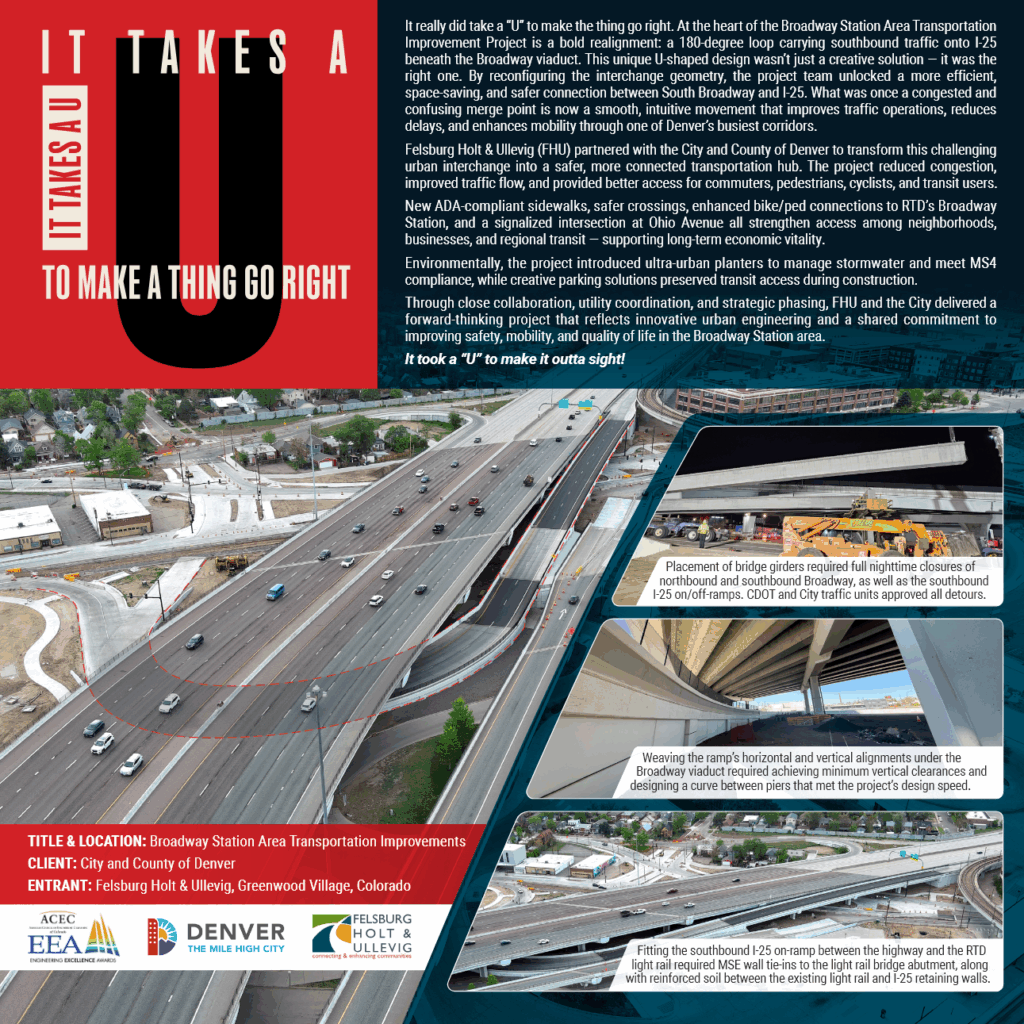PROBLEM: Serving as the prime consultant for the City and County of Denver’s Broadway Station Area Transportation Improvement Project, Felsburg Holt & Ullevig (FHU) delivered innovative solutions that transformed a constrained urban interchange into a safer, more connected multimodal hub. The project aimed to improve traffic operations along South Broadway and for South Broadway traffic accessing SB I-25, reconfigure the southbound I-25 on-ramp, implement ADA upgrades, enhance pedestrian and bicycle connectivity to the RTD Broadway Station, and commemorate the significance of the historic Broadway Trolley Line.
SOLUTION: FHU led the design and provided construction support services to this project located in an area constrained by the Broadway viaduct, existing utilities, RTD Broadway Station, adjacent neighborhoods, and major redevelopment parcels. The firm’s responsibilities spanned federal grant assistance, traffic operations analysis, updates to the interstate access request, and environmental clearance with a focus on hazardous materials and historic resources, and roadway and structural design. Other areas of responsibility included drainage, permanent water quality solutions, landscape and streetscape design, historic mitigation design, property acquisition, and extensive stakeholder and public engagement.
Key project innovations included the design of a complex southbound I-25 on-ramp featuring a 180-degree curve beneath the Broadway viaduct, constructed with mechanically stabilized earth (MSE) walls and bridges to navigate tight horizontal and vertical clearances and existing infrastructure. Water quality improvements integrated ultra-urban planters, simultaneously addressing MS4 compliance and tree mitigation requirements. Construction of the new southbound I-25 on-ramp reduced parking capacity at RTD’s Broadway Station. To offset this, permanent parking was added beneath the viaduct, within the area enclosed by the new ramp. The lot entrance passes beneath both the existing off-ramp and the new on-ramp bridges, which slope in opposite directions. This required precise vertical alignment of the southbound bridge to maintain a minimum 9.5-foot clearance beneath both structures.
FHU’s team design significantly enhanced multimodal safety by providing improved bicycle and pedestrian facilities and safer crossings along South Broadway. Notably, a new traffic signal at Ohio Avenue and the northbound I-25 ramps offers protected pedestrian phases, benefiting the neighborhoods’ access to the RTD Broadway Station and nearby businesses.
Project success depended on intricate utility coordination involving numerous public and private entities, complex property acquisitions from diverse owners, and precise construction phasing to maintain at least two lanes of traffic in each direction along South Broadway, except during critical bridge work. Maintaining consistent project leadership throughout the multiyear effort fostered a strong partnership between FHU and the City. Project collaboration enabled proactive stakeholder and public engagement, flexibility in adjusting priorities to secure funding, and strategic packaging of the overall project into three independent construction packages that minimized throwaway construction and managed costs effectively.
The Broadway Station Area Transportation Improvement Project stands as a model of engineering innovation and collaboration and demonstrates how complex urban infrastructure challenges can be overcome to enhance mobility and public safety, for the nearby neighborhoods and the general public passing through the project area.
